Recently, the hair care industry has taken interest in targeting products according to ethnic demographics, to respond to unique needs. In the U.S., ethnic hair products are sold in designated areas of retail stores to make the process of finding appropriate niche products more convenient. Moreover, this has initiated a discussion regarding which hair types fall under the umbrella of “es typically quite wavy or curly as well.1
Beneath the ethnic hair umbrella are various ethnicities that present diverse hair fiber compositions, which require unique products. For example, straightening pthnic.” For example, again in the U.S., ethnic hair refers to hair of African or Hispanic descent that is very curly. Central American and South American hair types, e.g., Brazilian, Colombian, Venezuelan, etc., also could be included, as hair from these descents iroducts based upon guanidine hydroxide, sodium hydroxide and ammonium thioglycolate are frequently used to straighten African-American, Brazilian, Colombian, Venezuelan and Hispanic hair having wavy or very curly textures. Similarly, shampoos with 1% to 1.50% levels of cationic polymers are used to cleanse and detangle wavy/very curly hair. Such detangling shampoos, if used daily on straight Caucasian hair, will leave a polymeric residue buildup. Thus, a comprehensive review of the differences in hair fiber dimensions among straight, wavy and curly/coily hair is necessary to guide formulators as they develop products that cater to unique hair type needs.
Fiber Diameter vs. Shape
In the literature, hair fiber diameter has been identified as the distinguishing factor to classify fibers as fine, medium or coarse. Assuming the hair fiber is cylindrical in shape, this system remains appropriate across a variety of populations. Asian or Oriental and straight Caucasian hair, for example, tend to be more cylindrical.
However, wavy, curly and very curly hair tends to be more elliptical. In this case, hair fibers may instead be described by two diameters along their width: the major and minor axes, since the cross-sectional shape is elliptical rather than circular. As Morton and Hearle observed2 in a study of cotton fibers, variances in major and minor axes give cotton fibers convoluted dimensions; i.e., their apparent width changes along the length of the fiber. Given the similarity between cotton and keratin fibers, curly and coily Caucasian, Hispanic and African hair fibers also can be convoluted, having many twists and curves along the fiber shaft.
The ellipticity of a hair fiber is defined as the ratio of the diameter of the major axis to the minor axis3 (see Figure 1), and this been found to correlate to other fiber properties such as elasticity and ease of combing. For example, Syed et al. observed that hair of African descent having higher ellipticity exhibited less fiber strength than Caucasian hair with lower ellipticity. African hair fibers with an ellipticity index of 1.8297 ± 0.1456 exhibited 42.04% ± 4.9% elongation at the break point (wet), compared with Caucasian hair fibers of an ellipticity of 1.2887 ± 0.1182, which exhibited 61.61% ± 4.1% at the break point (wet).4 Similarly, hair fibers of African descent, in both wet and dry states and having high ellipticities, were found to be more difficult to comb than Caucasian fibers.5
High fiber ellipticity connotes that fibers are wavy and curly/coily, are not easy to comb, and have less strength. Therefore, product development chemists could choose ingredients for formulations to help increase both ease of combing and fiber strength in these hair types. Ingredients such as quaternary molecules with higher fatty chains and cationic polymers with high cationic charge, for example, may be incorporated to improve ease of combing for highly elliptical hair fibers.
Determining Ellipticity
The theoretical framework of the present study was to determine the ellipticity of various hair samples and to correlate them with ethnic type. According to Hrdy, fiber ellipticity can be determined by placing a fiber between two glass slides under a microscope equipped with a micrometer. The length of the fibers can then be scanned to measure fiber diameters at many points along the length.6
Kamath and Hornby studied the ellipticity of hair of African descent along the twisted region of a single fiber by cutting fibers into cross sections and examining their ellipticity.7 A fiber was embedded in an epoxy resin and very thin slices of hair were prepared using microtome with a glass knife. The cross sections of the fiber were collected at 250, 300, 370, 460 and 530 microns from an arbitrary reference point (0 µm), and the diameters of the major and minor axes were measured using an optical microscope. An average ellipticity of 1.895 ± 0.083 was reported for African-American hair at 65% relative humidity (RH) in the twisted region of the fiber, which led the authors to postulate that hair fibers of African descent with high ellipticities display a flattened, collapsed appearance.8
This method by Kamath and Hornby to determine ellipticity unfortunately is time-consuming and not robust enough to scan the whole fiber to ascertain better statistics along the fiber length. Instead, according to Keise, Ramaprasad and Kamath, fiber cross-sectional area and ellipticity can be measured using a laser micrometer.9 However, their study, as referenced in the literature, did not provide details or specifications of this method, and no mention was made regarding scanning along the fiber length or intervals of measurements along the fiber length. These authors found that African-American, Caucasian and Indian (Asian) fibers have ellipticity indices of 1.60, 1.46 and 1.44, respectively.
Another study by Franbourg et al. compared the geometry of Caucasian, Asian and African hair10 by assembling an optical laser devicea to produce a 3-D reconstruction of hair fibers. The hair fiber was arranged as a bow in order to rotate, raise and lower it with a scan amplitude of 5–500 µm. The authors collected fiber data in terms of small and large diameters, cross section of the fibers, ellipticity, and ellipticity variability using the co-efficient of variation. These researchers found that more circular fibers had a higher ellipticity ratio; in fact, the ellipticity of African hair fibers was found to be lower than Caucasian and Asian hair fibers—in contrast to Kamath’s and Hornby’s findings. The authors also calculated the variation in ellipticity for these three ethnic groups.
Within the literature, ellipticity is primarily defined as the ratio of major axis divided by minor axis; this is not the definition used by Franbourg et al. However, if the Franbourg data for large and small diameters is converted to follow this definition, the hair fibers of African descent had the highest ellipticity, i.e., 1.78, followed by Caucasian and Asian fibers at 1.33 and 1.23, respectively. Interestingly, in later studies, Franbourg and Leroy11 cited ellipticities of 1.75, 1.35 and 1.25 for African, Caucasian, and Asian groups, respectively, which seems to agree with the results of converting data from their first study using the definition of ellipticity as being major axis divided by minor axis.
The literature also generally has measured ellipticity using an optical microscope equipped with an eyepiece featuring a grid scale, which allows for the facile measurement of major and minor axes. However, fiber-scanning methods are not typically used in the cited diameter measurements, thus only data point measurements at 1-mm intervals were made, potentially omitting important changes in ellipticity at smaller length scales. Similarly, the image analysis technique combined with a compound microscope ascertains data points at 1-mm intervals, and may have missed important changes in ellipticity along the fiber length due to the convoluted nature of the fibers.
To rectify these potential omissions in measurements, the authors devised a method to determine ellipticity based on a laser micrometer.12 Using this method, three hypotheses were examined: that ellipticity within a fiber varies significantly, that ellipticity changes from fiber to fiber for the same individual, and that ellipticities of various ethnicities are not similar. To formulators, knowing the fiber profile of ethnic hair enables the development of relevant products, such as those to improve ease of combing so as to avoid breakage during wet and dry combing.
Materials and Methods
Measurement assembly: For the described tests, one end of a 6-cm long fiber was attached to the upper grip of a stress/strain instrument with a column having the capability to move longitudinally at a very precise and constant rate. This 6-cm long sample provided an adequate scanning length of 5 cm along the fiber. The lower end of the fiber was attached to a 3.9-g alligator clip to hold the fiber in a straight configuration. The weight of the alligator clip also prevented any apparent twisting in the fiber. The column moved the fiber at a speed of 5 mm per minute through the laser micrometer window.
The laser micrometer used consisted of a dual axis scanner with two X and Y transmitters, which measure the fiber diameter by sweeping a beam of laser light across the measurement area. Each sweep of the beam is called a scan, and the scanner scans a fiber about 100 times per second. The scanner measures the fiber diameter in two axes separated by 90 degrees. As the beam sweeps through the scanner’s measurement area, it is alternately blocked by the hair fiber or allowed to pass through to the receiver end of the scanner. This action breaks each scan into segments of light and dark. The scanner measures the diameter cross-section of a hair fiber by detecting the size of the “shadow” or dark segment created by the hair fiber.
The received light is collected and focused on a photocell, converted into an electrical signal, and used by the optical processor to measure the diameter size of the hair fiber. A schematic diagram of the laser micrometer and load cell assembly is shown in Figure 2. Before scanning the hair fibers, the laser micrometer was calibrated with two stainless steel wires having standard diameters of 25 and 127 microns, per the National Institute of Standards and Technology recommendations.
The laser micrometer scanned the fiber diameter every 100 microns across the length of the fiber. The collected data for two axes was marked as X and Y. The data was then sorted for major and minor axis since the axis measurement for a single fiber would flip occasionally due to the convoluted and elliptical nature of the hair fibers. For example, the diameter of the X axis was initially observed as being larger than the Y axis but periodically became smaller. Thus, the X and Y axis traded the role of major axis along the hair fiber. This pattern was more prevalently observed in fibers with high ellipticity. The ellipticity was calculated as follows:
Eq. 1 Ellipticity= Major Axis/Minor Axis
The 6-cm fiber provided 500 ellipticity readings along the unclamped 5 cm of hair shaft, depicting the elliptical nature of a hair fiber better than the optical microscope method or image analysis technique combined with a compound microscope, as described in the literature.
Hair samples: Four ethnic hair types, i.e., Caucasian, Brazilian, Hispanic and African-American, were analyzed for their dimensions. In each category except Caucasian, five individual donors were selected based on their ethnic description. Brazilian fibers were collected from five different volunteers who frequented the Avlon Technical Center in São Paulo. These individuals described themselves as Brazilians of European descent. Hispanic hair fibers were collected from five volunteers at Avlon Research Center in Melrose Park, Ill., USA. These individuals described themselves as being of Mexican or Hispanic descent. African-American hair fibers were collected from five different African-American volunteers also from the Avlon Research Center in Melrose Park. These individuals described themselves as African-American and not being of mixed ethnicity. For the Caucasian group, five samples were taken from each of three batches from one commercial sourceb and two batches of anotherc. The Caucasian fibers were straight, whereas Brazilian and Hispanic fibers were wavy, and African-American fibers were very curly and coily in shape (see Figures 3–6).
Measurement process: Five fibers from each individual donor were scanned using the laser micrometer. The fiber scan measured the X and Y axis of the fibers at every 100 µm, which were then converted to major and minor axes. An abbreviated table showing just 100 data points from one African-American hair fiber donor (CM) is shown in Figure 7.
Results and Discussion
Upon examining a number of data points for the fiber, it becomes evident that flipping took place between major and minor axis repeatedly, and this occurred more frequently along the 500 data points (5 cm) in wavy and curly hair than in straight hair. Figure 7 indicates there were 10 flips between major and minor axis just along 100 data points in the hair fiber, accounting for a 1.0-cm fiber length.
In addition to the rotating major and minor axis, there is significant variation in the X and Y axis diameters. Thus, the coefficient of variation (CV), which indicates how large the standard deviation is in relation to the mean,13 was calculated to normalize the variability in hair fiber diameter. For the described CM1d African-American hair fiber, the major diameter X had a mean of 77.53 µm, a standard deviation of 13.60, and a CV of 17.53%. Likewise, the Y axis had a mean of 90.23 µm, a standard deviation of 11.0845 and a CV of 13.08%. These frequent shifts in the major and minor axis, and significant variation in the diameters in the X and Y directions, indicate a high degree of fiber diameter variability. For this one fiber, ellipticity ranges between 1.0118 and 1.8246, with a mean of 1.2546, a standard deviation of 0.1983, and a CV of 15.81%.
Hypothesis 1: Ellipticity within a fiber varies significantly. As noted, a total of 25 fibers per ethnicity were scanned and data was collected for X and Y axis diameters at every 100 µm along the fiber length. The ellipticity values calculated for each fiber in each group varied along the fiber length. Upon further analysis of ellipticity variation within a fiber, the CV was calculated for each ethnic group (see Figure 8). Notably, the variance in ellipticity, for example, of Fiber 18 was higher than 20%, although the remaining fibers had a lower CV within each. When the CV is higher than 20%, such a fiber is typically not used for stress/strain studies. Therefore, tests designed to measure the effects of a new product on fiber strength should first scan fiber ellipticity so that fibers with a high CV, i.e., more than 20.0%, can be omitted in order to avoid the impact of diameter variations on the test and produce misleading information for the new product.
The average CV for Caucasian fibers was 13.24% with only one fiber above 20%, whereas 10 Brazilian fibers had a CV above 20.0%, showing their higher degree of variation in ellipticity. Only five fibers in the Hispanic hair group had a CV above 20.0%, compared with the one Caucasian fiber and 10 Brazilian fibers. Similarly, seven fibers in the African hair group showed a CV above 20.0%, compared to one Caucasian, five Hispanic and 10 Brazilian fibers. The CV of various ethnic groups was ranked as shown in Table 1 using the Kruskal–Wallis test. This test divided the variations in fiber ellipticity into four groups. The lowest variation indicated that fiber diameter was uniform, the highest variation showed that fibers were very irregular in terms of diameter along the fiber length.
As noted, the Brazilian fibers showed the highest variability in CV, followed by African–American, Caucasian and Hispanic fibers at p < 0.05, respectively. The scan of actual ellipticities of fibers for each ethnic group across fiber length are shown in Figure 9.
Hypothesis 2: Average fiber ellipticity changes from fiber to fiber for the same individual. The ellipticities of five fibers from one individual for each ethnicity were compared using Tukey’s Analysis of Variance (ANOVA) Test. The results of this test are recorded in Tables 2 through 5, and show that the ellipticity of five fibers from a single individual vary significantly from fiber to fiber. For example, the ellipticities of five Caucasian fibers from a single batch fall into two significant sub-groups, at p < 0.05 (see Table 2). The ellipticities of five fibers of a Brazilian individual fall into four subgroups, at p < 0.05, as shown in Table 3. Further, the ellipticity of five fibers of a Hispanic individual fall into three distinct subsets, at p < 0.05, as shown in Table 4.
Similar to the fibers of a Brazilian individual, the ellipticities of five fibers of an African-American individual fall into four subgroups, at p < 0.05, as shown in Table 5. It was therefore concluded that fibers from one individual can possess significantly different ellipticities. To the formulator this means that before evaluating the impact of various hair products on elasticity, it is advisable to select fibers that are not significantly different in ellipticities and fiber diameters before conducting stress/strain tests.
Hypothesis 3: Ellipticities of various hair ethnicities are not similar. The ellipticity data from all fibers from each ethnicity were collected and tabulated into four groups. Groups 1 to 4 were assigned as Caucasian, Brazilian, Hispanic and African-American, respectively. The Tukey B ANOVA Test was again used to compare the ellipticity of each.
The Brazilian fibers had the highest average ellipticity as shown in Table 6, Tukey HSD, Subset 4, followed by African-American fibers in Subset 3. The Hispanic fibers had a higher average ellipticity than Caucasian hair fibers; see Table 6, Tukey HSD, Subset 2. The order of average ellipticity, at p < 0.05, was thus: Brazilian > African-American > Hispanic > Caucasian. However, the average ellipticity number does not show the true picture of the variation of ellipticity along a hair shaft, the average ellipticity and CV must be examined for each ethnicity simultaneously. For example, the average ellipticity and CV for Brazilian fibers (1.4309 and 24.13%) was higher than African-American fibers (1.3956 and 21.70%). Similarly, the average ellipticity for Hispanic fibers was 1.2988 with CV of 17.99%, compared with the average ellipticity of Caucasian fibers of 1.2776 with CV of 19.58%.
Although Brazilian fibers resembled Hispanic hair fibers in apparent shape or waviness, they exhibited higher variation in ellipticity than Hispanic hair fibers. This may be due to higher racial diversity in Brazilian populations, including those of African descent, than in Mexican/Hispanic populations. The Caucasian fibers were the most uniform with respect to average ellipticity. Therefore, formulating products for Mexican/Hispanic hair should almost follow similar formulating techniques for Caucasian hair, and the types and concentrations of ingredients in hair products would be similar for both Mexican/Hispanic and Caucasian hair products.
Comparing the numbers: According to Franbourg and Leroy, the ellipticity for African, Caucasian and Asian fibers was 1.75, 1.35 and 1.25, respectively. Similarly, Kamath and Hornby reported the ellipticty of African-American fibers at 1.895. As noted, Keise, Ramaprasad and Kamath reported ellipticity of 1.66, 1.46, and 1.44 for African-American, European and Indian (Asian) fibers, respectively. In fact, in a recent article, Bryant and Porter reported an ellipticity of 1.66 ± 0.02, 1.41 ± 0.03 and 1.29 ± 0.03 for African-American, Caucasian, and Asian hair, respectively.14 In the present study, the average ellipticity of African-American fibers was 1.3956 ± 0.3028, with an ellipticity range of 2.29. Similarly, the average ellipticity for Caucasian fibers was 1.2776 ± 0.2501, with an ellipticity range of 1.34.
Although the average ellipticity values of the Kamath and Hornby, Franbourg and Leroy, and Bryant and Porter studies were higher than the findings of the present study, they fall within the given ellipticity ranges. From these findings, the authors observe that scanning a single fiber at intimate intervals, such as 100 µm per reading along the fiber length, and collecting 500 data points per fiber, i.e., 5 cm in length, has produced the closest picture of the actual ellipticity of a given fiber.
These results emphasize the importance of considering hair fiber ellipticity as products are designed for given market segments. Elasticity tests conducted on fibers with a very high ellipticity and CV would yield erroneous results, thus guiding the formulating chemist in the wrong direction. It therefore is advisable to test newly formulated product prototypes on fibers with the lowest ellipticity and lowest CV in order to gauge the impact of a newly formulated product on fiber elasticity.
Conclusion
A more detailed picture of hair fiber variations between ethnic types was obtained in this study as the four types considered displayed significantly different average ellipticity values (p < 0.05). The highly sensitive laser micrometer method described, which scans each fiber at 100 µm intervals, compared with optical microscope or image analysis methods, which scan at 1-mm intervals, proved to be a viable technique to accurately detect the degree of convolution in Brazilian and African-American hair fiber dimensions.
Individual hair fibers of Euro-Brazilian descent exhibited the largest ellipticity variation, followed by African- American, Hispanic and Caucasian fibers. Although Brazilian fibers appear similar in waviness to Hispanic hair, it was found that the former varies most turbulently in hair fiber dimension, exhibiting the highest ellipticity range of 3.24 and average CV of 24.13% (see Table 6). The average ellipticity of Euro-Brazilian fibers was 1.4309 ± 0.3453, compared with the average ellipticity of 1.3956 ± 0.3028 for African-American fibers; 1.2988 ± 0.2337 for Hispanic fibers; and 1.2776 ± 0.2501 for Caucasian fibers.
Furthermore, it was shown that depending upon ethnic origin, hair fibers selected from one individual also show significant variation in ellipticity, at p < 0.05. For example, fibers from one Euro-Brazilian or African-American individual varied significantly in hair fiber dimension, whereas Hispanic and Caucasian fibers showed relatively more uniform fiber dimensions. This finding in itself changes the method in which ellipticity and elasticity studies will be conducted. In the past, many elasticity studies utilized hair fibers from one individual assuming they were very similar. However, it is now clear that each fiber from an individual can vary significantly from one another, so an ellipticity scan must be conducted on a fiber batch before testing elasticity before and after product treatments. As noted, the present work is a preliminary study based on five fibers per person and five people per ethnic group. Note that if the sample size of the study were to be increased in the future, the average ellipticity of an ethnic group may change somewhat.
References
Send e-mail to [email protected].
1. AN Syed, Ethnic hair care, in DH Johnson, ed, Hair and Hair Care, Marcel Dekker, New York (1997)
2. WE Morton and JWS Hearle, Physical Properties of Textile Fibres, The Textile Institute, Manchester (1986) p 124
3. AN Syed, Hair straightening, in ML Schossman, ed, The Chemistry and Manufacture of Cosmetics, vol II, Allured Business Media, Carol Stream, IL, USA (2000)
4. AN Syed, A Kuhajda, H Ayoub, K Ahmad and EM Frank, African-American hair: Its physical properties and differences relative to Caucasian hair, Cos & Toil 110 39–48 (1995)
5. Ibid Reference 4, p 46
6. D Hrdy, Hair form variations in seven populations, Am J Phys Anthrop 39 7–18 (1973)
7. YK Kamath and SB Hornby, Mechanical and fractographic behavior of Negroid hair, J Soc Cosmet Chem 35 21–43 (1984)
8. Ibid Reference 7, p 26
9. K Keise, KR Ramaprasad and YK Kamath, Studies of light scattering from ethnic hair fibers, J Cosmet Sci 55 49–63 (2004)
10. A Franbourg, P Hallegot, F Baltenneck, C Toutain and F Leroy, Current research on ethnic hair, J Amer Acad Dermatol 48/6S 115S–119S (2003)
11. A Franbourg and F Leroy, Hair structure, function and physicochemical properties, in C Bouillon and J Wilkinson, eds, The Science of Hair Care, 2nd edn, Taylor and Francis, Boca Raton (2005)
12. LaserMike Inc., Operator’s manual, Dayton, Ohio USA (1995)
13. DR Anderson, DJ Sweeney and TA Williams, Statistics for business and economics, 6th edn, West Publishing Company, Minneapolis/St. Paul, USA (1996)
14. H Bryant and CE Porter, Hair ethnicity, in Trefor Evans and RR Wickett, eds, Practical Modern Hair Science, Allured Business Media, Carol Stream, IL USA.
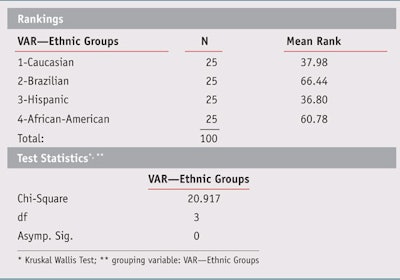
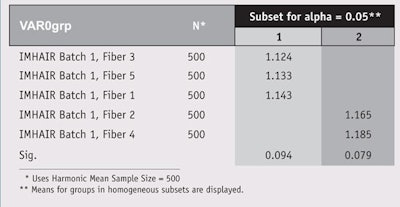
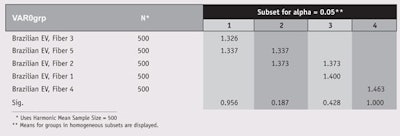
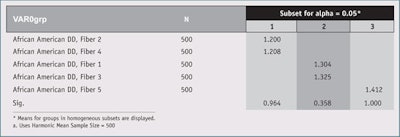
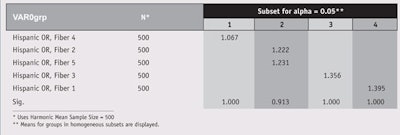
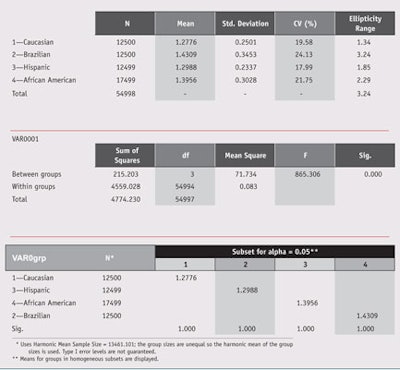





!['We believe [Byome Derma] will redefine how products are tested, recommended and marketed, moving the industry away from intuition or influence, toward evidence-based personalization.' Pictured: Byome Labs Team](https://img.cosmeticsandtoiletries.com/mindful/allured/workspaces/default/uploads/2025/08/byome-labs-group-photo.AKivj2669s.jpg?auto=format%2Ccompress&crop=focalpoint&fit=crop&fp-x=0.49&fp-y=0.5&fp-z=1&h=191&q=70&w=340)




